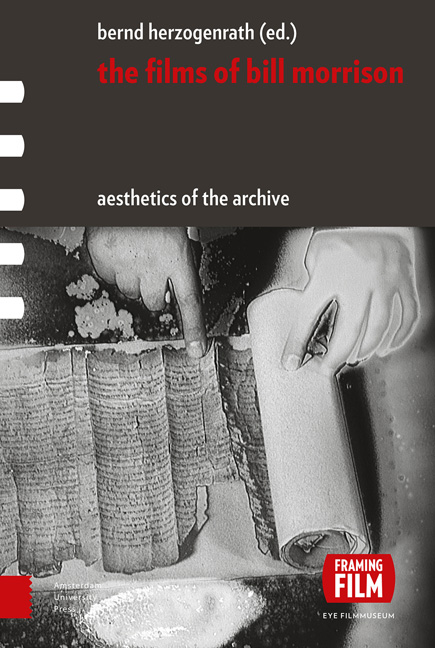Book contents
- Frontmatter
- Contents
- Acknowledgments
- Aesthetics of the Archive: An Introduction
- Chapter 1 Drafts and Fragments: Reflections around Bill Morrison and the Paper Print Collection
- Chapter 2 The Film of Her: The Cine-Poet Laureate of Orphan Films
- Chapter 3 Ghost Trip: Searching for Potential Myths
- Chapter 4 Decasia: The Matter | Image: Film is also a Thing
- Chapter 5 The Mesmerist: Illustrating the Return of the Repressed
- Chapter 6 Light is Calling: Celluloid Dreams
- Chapter 7 Gotham: Zoetrope: Block by Block
- Chapter 8 Outerborough: Early Cinema Revisited
- Chapter 9 The Highwater Trilogy: Thinking the Liquid – On the Ethics of Water and the Material Ecologies of Disaster and Ruination
- Chapter 10 Porch: Archives, Collective Memory, and the Poetics of Home Movies
- Chapter 11 The Future Lasts Long: The Romanov Lost Family Archives
- Chapter 12 Who by Water: Variations on Matter, Figures, Memory, and Mythology
- Chapter 13 Every Stop on the F-Train: Beyond and within the Restless Netherworld of (Manhattan’s) Mind
- Chapter 14 Spark of Being: Bachelor Machine
- Chapter 15 The Miners’ Hymns: Acts of Resurrection
- Chapter 16 Tributes – Pulse: A Requiem for the 20th Century: Death | Drive | Image
- Chapter 17 Just Ancient Loops: The Loops of Life in Intonation
- Chapter 18 The Great Flood: Water is Transparence Derived from the Presence of Everything
- Chapter 19 Re-Awakenings: Bill Morrison in Conversation
- Index of Film Titles
- Index of Names
- Index of Subjects
- Already Published
Chapter 4 - Decasia: The Matter | Image: Film is also a Thing
Published online by Cambridge University Press: 12 December 2020
- Frontmatter
- Contents
- Acknowledgments
- Aesthetics of the Archive: An Introduction
- Chapter 1 Drafts and Fragments: Reflections around Bill Morrison and the Paper Print Collection
- Chapter 2 The Film of Her: The Cine-Poet Laureate of Orphan Films
- Chapter 3 Ghost Trip: Searching for Potential Myths
- Chapter 4 Decasia: The Matter | Image: Film is also a Thing
- Chapter 5 The Mesmerist: Illustrating the Return of the Repressed
- Chapter 6 Light is Calling: Celluloid Dreams
- Chapter 7 Gotham: Zoetrope: Block by Block
- Chapter 8 Outerborough: Early Cinema Revisited
- Chapter 9 The Highwater Trilogy: Thinking the Liquid – On the Ethics of Water and the Material Ecologies of Disaster and Ruination
- Chapter 10 Porch: Archives, Collective Memory, and the Poetics of Home Movies
- Chapter 11 The Future Lasts Long: The Romanov Lost Family Archives
- Chapter 12 Who by Water: Variations on Matter, Figures, Memory, and Mythology
- Chapter 13 Every Stop on the F-Train: Beyond and within the Restless Netherworld of (Manhattan’s) Mind
- Chapter 14 Spark of Being: Bachelor Machine
- Chapter 15 The Miners’ Hymns: Acts of Resurrection
- Chapter 16 Tributes – Pulse: A Requiem for the 20th Century: Death | Drive | Image
- Chapter 17 Just Ancient Loops: The Loops of Life in Intonation
- Chapter 18 The Great Flood: Water is Transparence Derived from the Presence of Everything
- Chapter 19 Re-Awakenings: Bill Morrison in Conversation
- Index of Film Titles
- Index of Names
- Index of Subjects
- Already Published
Summary
ABSTRACT
This essay focuses on the nexus of film, time, and materiality. Film is, by default, seen as a representation of time – Decasia goes a decisive step further by focussing on the temporality of or in the filmic material.
Put together from found footage and archive material in various states of ‘dying’, this film reveals the ‘collaboration’ of time and matter as in itself ‘ creative’ and ultimately produces a category that one might call the matter-image and that neither Deleuze's movement-image, nor his time-image completely grasp: here, time and matter produce their own filmic image.
KEYWORDS
Gilles Deleuze, Georg Simmel, Walter Benjamin, Charles Sanders Peirce
Bill Morrison's Decasia (2002) can be located in the tradition of the American avant-garde or experimental film of the 1960s and 1970s. A main characteristic of this tradition is its focus on the filmic material and on the structure of film. Filmmakers such as Bruce Connor, Robert Breer, and Tony Conrad worked with the concept of flicker-film that undermined classic filmic temporality (and its concomitant continuity-effect) – 24 frames per second – and experimented with various tempi. Andy Warhol rediscovered early cinema's stylistic device of the ‘static camera’ and made duration the explicit topic of films such as Empire, Sleep, and Eat. Ken Jacobs, George Landow, and others utilized the concept of found footage for the experimental film, while Stan Brakhage produced films completely without a camera, by what Peirce would have called ‘indexical’ procedures – putting objects directly on the filmstrip to be processed, by painting or scratching on its surface, for example. It was Brakhage's self-expressed aim to decouple the filmic image from its hegemonic relation to memory, to deconstruct the images’ representational character and to create a ‘sense of constant present-tense’ (Brakhage 2005, 210) – not a representation of the past, but a presentation of temporalities or of durations. Common to all these experiments was the desire to make the filmic material itself – under ‘classic circumstances’ invisible due to the ideal of the transparency of the medium according to which film is ‘the material base that must be dematerialized in projection’ (Stewart 1999, 3) – visible and fruitful as a fundamental component of the filmic process.
- Type
- Chapter
- Information
- The Films of Bill MorrisonAesthetics of the Archive, pp. 83 - 96Publisher: Amsterdam University PressPrint publication year: 2017



